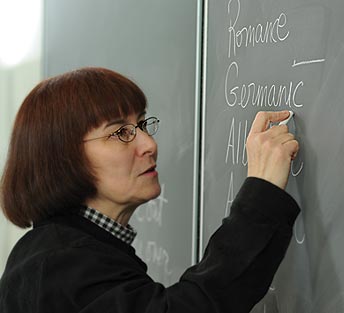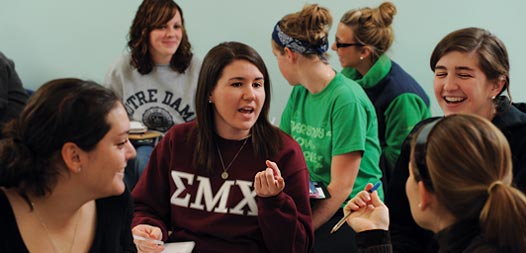Multicultural Approaches to Teaching Reading
By Natalie Davis Miller

Professor Loretta Li is listening. She’s listening to her students, what they say and how they say it. For her, playing with words is fun and it’s her goal to bring recognition of “dialect diversity” to the Saint Mary’s students in her class.
As an associate professor in the education department, she’s taught Multicultural Approaches to the Teaching of Reading for the past twelve years. In this class she works with preservice teachers, preparing them to work with Kindergarten through sixth (K-6) grade students. “We try to explore language, first and second languages, and third languages, various dialects, and we talk about the role of language. We talk about how languages are formed and how language relates to reading. And we hope to investigate our own dialects and then apply our knowledge in the field.”
Her students are junior and senior education majors taking reading as a minor. Their classwork includes going into the field and identifying the dialect of a K-6 student. They write about how they know the student is speaking a particular dialect and then do a contrastive analysis chart, contrasting one dialect with another. They also study storytelling because, Li says,“There are quite a few groups that rely more on an oral tradition. Hopefully they are learning more stories to tell.”
Given all that they do with the K-6 student, one of the first things the preservice student needs to do is identify their own dialect by first acknowledging that they have one. Li explains, “In the past I would have students who would say ‘I don’t speak any dialect.’” Li encourages her students to compare their dialects with each other. “I hope to create a kind of thoughtfulness in the preservice teacher that leads to respect of different dialects, and maybe even an appreciation. We certainly are a nation of a lot of different groups, Native Americans and African Americans and different immigrant groups. Of course we would have a lot of different dialects; we wouldn’t expect it to be any different.”

Students in Professor Loretta Li’s class Multicultural Approaches to the Teaching of Reading study how students read and speak, and the effects of cultural dialects.
Li’s class looks at how teachers teach reading to different groups of children and what different methods have succeeded in the past. The teaching of reading in her course is not just about decoding, but about comprehension. She’s also not about teaching oral reading or reading aloud. “In fact we don’t want to change a child’s dialect. We would like to add the regional standard,” comments Li, on what some would consider to be a move from practices of the past. “We have a long history of eradication of first languages and dialects,” explains Li, “so if the teacher could encourage the first language or the first dialect, that would really be different.”
Li’s spring ’08 class consists of about 15 students. As can be imagined, class time is very vocal, with students reading different regional phrases and discussing whether or not they use a certain colloquialism, or if they speak a certain word with a different pronunciation. As Li’s students compare and contrast with each other, Li’s motivation is apparent.
“What we’re really hoping for is an appreciation of the variety of dialects in the United States so that when a teacher encounters students who have different dialects they have a welcoming attitude towards those students. That’s what I’m really hoping for.”

